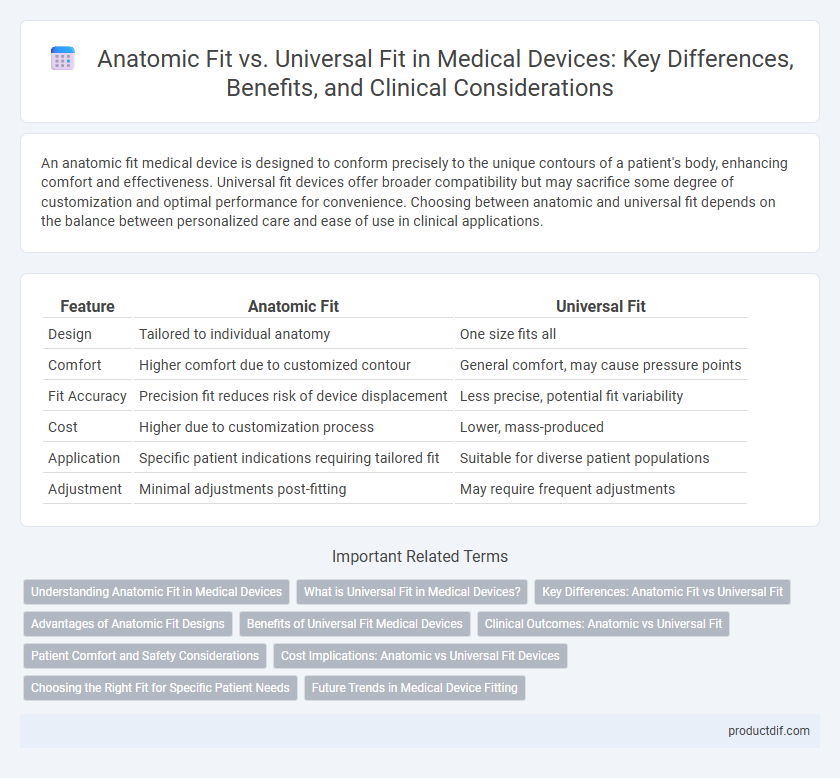An anatomic fit medical device is designed to conform precisely to the unique contours of a patient's body, enhancing comfort and effectiveness. Universal fit devices offer broader compatibility but may sacrifice some degree of customization and optimal performance for convenience. Choosing between anatomic and universal fit depends on the balance between personalized care and ease of use in clinical applications.
Table of Comparison
| Feature | Anatomic Fit | Universal Fit |
|---|---|---|
| Design | Tailored to individual anatomy | One size fits all |
| Comfort | Higher comfort due to customized contour | General comfort, may cause pressure points |
| Fit Accuracy | Precision fit reduces risk of device displacement | Less precise, potential fit variability |
| Cost | Higher due to customization process | Lower, mass-produced |
| Application | Specific patient indications requiring tailored fit | Suitable for diverse patient populations |
| Adjustment | Minimal adjustments post-fitting | May require frequent adjustments |
Understanding Anatomic Fit in Medical Devices
Anatomic fit in medical devices ensures precise conformity to individual patient anatomy, enhancing comfort, effectiveness, and reducing the risk of complications compared to universal fit designs. Customization based on detailed anatomical data improves outcomes in devices such as prosthetics, orthotics, and wearable monitors by providing better alignment and support. This tailored approach supports optimal clinical performance and patient adherence, driving advancements in personalized medical care.
What is Universal Fit in Medical Devices?
Universal fit in medical devices refers to products designed to accommodate a broad range of anatomical variations, enabling a single device to be used across multiple patient types without customization. This approach enhances inventory efficiency and reduces costs by minimizing the need for numerous size-specific models. Universal fit devices often utilize adjustable components or flexible materials to ensure proper functionality and comfort for diverse users.
Key Differences: Anatomic Fit vs Universal Fit
Anatomic fit medical devices are designed to conform precisely to patient-specific body contours, enhancing comfort and functionality through individualized customization. Universal fit devices use standardized dimensions to accommodate a broad range of users, prioritizing versatility and ease of manufacturing but often at the expense of optimal comfort and performance. Key differences include the level of customization, with anatomic fit offering superior adaptation to anatomical variations, while universal fit emphasizes accessibility and cost-efficiency across diverse populations.
Advantages of Anatomic Fit Designs
Anatomic fit designs in medical devices offer superior comfort and enhanced functionality by closely matching the natural contours of the human body, reducing pressure points and improving device stability. These custom-tailored solutions contribute to better patient compliance and lower risk of skin irritation or injury compared to universal fit devices. Enhanced biometric compatibility also leads to more accurate therapeutic outcomes and optimized performance in clinical applications.
Benefits of Universal Fit Medical Devices
Universal fit medical devices offer increased accessibility by accommodating a wide range of body types and sizes, reducing the need for custom fittings. They enhance inventory efficiency and lower costs for healthcare providers through standardized designs. The adaptability of universal fit devices also streamlines clinical workflows and improves patient compliance by simplifying device selection and usage.
Clinical Outcomes: Anatomic vs Universal Fit
Anatomic fit medical devices provide tailored alignment to patient-specific body contours, resulting in enhanced comfort, reduced pressure points, and improved therapeutic efficacy. Clinical outcomes demonstrate that anatomic fit devices significantly lower complication rates, such as tissue irritation and device displacement, compared to universal fit models. Studies reveal increased patient compliance and accelerated recovery times when using anatomic fit devices due to their superior biomechanical compatibility.
Patient Comfort and Safety Considerations
Anatomic fit medical devices are designed to conform precisely to the unique contours of individual patients, enhancing comfort by reducing pressure points and minimizing skin irritation. Universal fit devices prioritize adaptability to a broad patient population but may compromise comfort and safety due to less precise alignment, potentially increasing risks of device displacement or tissue damage. Clinical studies demonstrate that anatomic fit solutions contribute to improved patient compliance and lower incidence of device-related complications, emphasizing their importance in personalized medical care.
Cost Implications: Anatomic vs Universal Fit Devices
Anatomic fit medical devices typically incur higher manufacturing and material costs due to the customization required for patient-specific anatomical features, leading to increased production time and expenses. Universal fit devices offer cost advantages through standardized design and mass production, reducing per-unit costs and simplifying inventory management. However, potential trade-offs in patient outcomes and device effectiveness may impact overall healthcare expenditures and long-term cost-effectiveness.
Choosing the Right Fit for Specific Patient Needs
Anatomic fit medical devices are designed to closely match the patient's unique body contours, ensuring enhanced comfort, stability, and functional alignment. Universal fit devices offer a standardized size intended to accommodate a broad range of patients but may lack precision and personalized support. Selecting the right fit depends on the patient's specific anatomical variations, clinical requirements, and the desired balance between customization and convenience.
Future Trends in Medical Device Fitting
Future trends in medical device fitting emphasize personalized anatomic fit using advanced imaging and 3D printing technologies to create customized devices that improve patient comfort and efficacy. Universal fit options remain relevant for cost efficiency and rapid deployment, but innovations aim to narrow the gap by incorporating adaptive materials and AI-driven adjustments. Integration of digital health data and real-time monitoring will further refine fit precision, enhancing clinical outcomes and patient satisfaction.
Anatomic fit vs Universal fit Infographic

 productdif.com
productdif.com